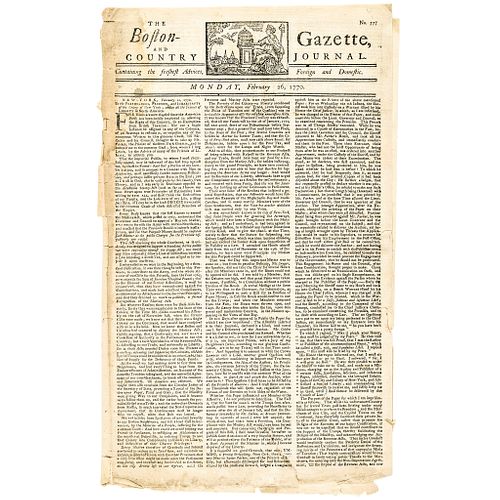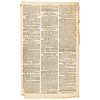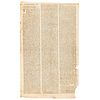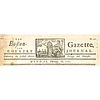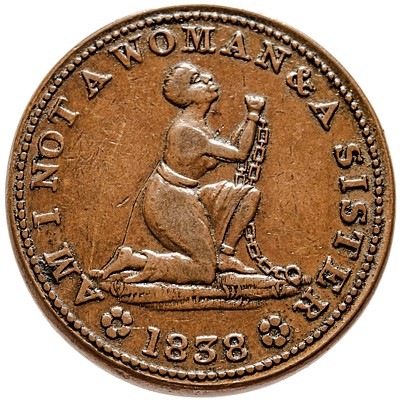1770 Paul Revere Masthead Boston Gazette Newspaper Prior to the Boston Massacre!
Lot 303
Categories
Estimate:
$1,800 - $2,800
Absentee vs Live bid
Two ways to bid:
- Leave a max absentee bid and the platform will bid on your behalf up to your maximum bid during the live auction.
- Bid live during the auction and your bids will be submitted real-time to the auctioneer.
Bid Increments
| Price | Bid Increment |
|---|---|
| $0 | $10 |
| $200 | $20 |
| $300 | $25 |
| $500 | $50 |
| $1,000 | $100 |
| $2,000 | $200 |
| $3,000 | $250 |
| $5,000 | $500 |
| $10,000 | $1,000 |
| $20,000 | $2,000 |
| $30,000 | $2,500 |
| $50,000 | $5,000 |
| $100,000 | $10,000 |
| $200,000 | $20,000 |
| $300,000 | $25,000 |
| $500,000 | $50,000 |
About Auction
By Early American History Auctions
Feb 27, 2021
Set Reminder
2021-02-27 12:00:00
2021-02-27 12:00:00
America/New_York
Bidsquare
Bidsquare : Black History & Slavery, Historic Autographs, Colonial America & Weapons
https://www.bidsquare.com/auctions/early-american-history-auctions/black-history-slavery-historic-autographs-colonial-america-weapons-6434
318 Lots of Rare, Historic Autographs, Americana, Civil War Era, George Washington, Abraham Lincoln, Slavery & Black History, Revolutionary War Era, Colonial America, Federal Period, War of 1812, Colonial Currency, Historic Early American Guns & more... Early American History Auctions auctions@earlyamerican.com
318 Lots of Rare, Historic Autographs, Americana, Civil War Era, George Washington, Abraham Lincoln, Slavery & Black History, Revolutionary War Era, Colonial America, Federal Period, War of 1812, Colonial Currency, Historic Early American Guns & more... Early American History Auctions auctions@earlyamerican.com
- Lot Description
American Revolution
February 26, 1770 Boston Gazette Paul Revere Masthead Newspaper One Week Prior to the "Boston Massacre"
February 26, 1770-Dated Paul Revere Engraved Masthead Newspaper titled, "The Boston Gazette and Country Journal," Issued One Week before "The Boston Massacre" Occured on March 5th, 1770, reporting on the Rising Tensions in Boston that Led to the "Boston Massacre" just one week later, Very Fine.
This rare original "The Boston Gazette and Country Journal," Printed by Edes & Gill in Queen Street, Boston 1770. This Newspaper measures about 9.5" x 15.5", with 4 pages, and is Complete. Fold along its center, spine splits, some edge chips, overall well printed and mostly clean. This issue has a rare Masthead Engraved by Paul Revere which is extremely well printed, sharp and distinct in eye appeal. The entire front page and first column of page 2 is an essay by Alex McDougall written from the Goal (jail) in New York and rants against "the detestable Stamp-Act" and other British provocations including the stationing of Troops.
Alexander McDougall (1732-1786) was an American seaman, merchant, a Sons of Liberty Leader from New York City before and during the American Revolution, and a Military Leader during the Revolutionary War. He served as a Major General in the Continental Army, and as a Delegate to the Continental Congress. After the war, he was the President of the first bank in the State of New York and served a term in the New York State Senate. His fiery Patriotic Anti-British Crown column reads, in part:
"To the Freeholders, Freemen, and Inhabitants of the Colony of New York, and to all the Friends of LIBERTY in North-America. - Five years are now elapsed since the American Press has been boldly imployed in asserting the Right of this Country, to an Exemption from British Taxation: Nor can a single Instance be assigned in any of the Colonies, of an Attempt to restrain it, or imprison any of its numerous Writers in this glorious Cause, till Mr. Colden and his Council, thought fit to take up Mr. Parker, the Printer of the New-York Gazette, and to commit me to the common Goal; from whence I beg Leave, by the Advice of may of the Friends of Liberty, to address you..."
Also includes a notice to the publishers that, "You may with Confidence, assure your female Readers, that a Number of the principal Ladies in Connecticut, have wholly discarded foreign Tea, 'til the Revenue Acts are repealed...". Plus, many notices and advertisements. Perhaps it was the inflamatory speech in this very newspaper which led to the incident known as "The Boston Massacre".
The Boston Massacre was a street fight that occurred on March 5, 1770, between a "patriot" mob, throwing snowballs, stones, and sticks, and a squad of British soldiers. Several colonists were killed and this led to a campaign by speech-writers to rouse the ire of the citizenry. All victims of the Massacre, Crispus Attucks, Samuel Gray, James Caldwell, Samuel Maverick and Patrick Carr, were buried at Granary Burying Ground in Boston.
What began as a street brawl between American colonists and a lone British soldier, but quickly escalated to a chaotic, bloody slaughter. The conflict energized anti-Britain sentiment and paved the way for the American Revolution.
Tensions ran high in Boston in early 1770. As more than 2,000 British soldiers occupied the city of 16,000 colonists and tried to enforce Britain's tax laws, American colonists rebelled against the taxes they found repressive, rallying around the cry, "no taxation without representation."
Skirmishes between colonists and soldiers - and between patriot colonists and colonists loyal to Britain (loyalists) - were increasingly common. To protest taxes, patriots often vandalized stores selling British goods and intimidated store merchants and their customers.
On February 22, a mob of patriots attacked a known loyalist's store. Customs officer Ebenezer Richardson lived near the store and tried to break up the rock-pelting crowd by firing his gun through the window of his home. His gunfire struck and killed an 11-year-old boy named Christopher Seider and further enraged the patriots.
Several days later, a fight broke out between local workers and British soldiers. It ended without serious bloodshed but helped set the stage for the bloody incident yet to come.
On the frigid, snowy evening of March 5, 1770, Private Hugh White was the only soldier guarding the King's money stored inside the Custom House on King Street. It wasn't long before angry colonists joined him and insulted him and threatened violence.
At some point, White fought back and struck a colonist with his bayonet. In retaliation, the colonists pelted him with snowballs, ice and stones. Bells started ringing throughout the town - usually a warning of fire - sending a mass of male colonists into the streets. As the assault on White continued, he eventually fell and called for reinforcements.
In response to White's plea and fearing mass riots and the loss of the King's money, Captain Thomas Preston arrived on the scene with several soldiers and took up a defensive position in front of the Custom House.
Worried that bloodshed was inevitable, some colonists reportedly pleaded with the soldiers to hold their fire as others dared them to shoot. Preston later reported a colonist told him the protestors planned to "carry off [White] from his post and probably murder him."
The violence escalated, and the colonists struck the soldiers with clubs and sticks. Reports differ of exactly what happened next, but after someone supposedly said the word "fire," a soldier fired his gun, although it's unclear if the discharge was intentional.
Within hours, Preston and his soldiers were arrested and jailed and the propaganda machine was in full force on both sides of the conflict.
Preston wrote his version of the events from his jail cell for publication, while Sons of Liberty leaders such as John Hancock and Samuel Adams incited colonists to keep fighting the British. As tensions rose, British troops retreated from Boston to Fort William.
Paul Revere encouraged anti-British attitudes by etching a now-famous engraving depicting British soldiers callously murdering American colonists. It showed the British as the instigators though the colonists had started the fight.
It also portrayed the soldiers as vicious men and the colonists as gentlemen. It was later determined that Revere had copied his engraving from one made by Boston artist Henry Pelham.
The Boston Massacre had a major impact on relations between Britain and the American colonists. It further incensed colonists already weary of British rule and unfair taxation and roused them to fight for independence.
Our Auction Contents:
Black History & Slavery: (Lots 1 - 63)
Abraham Lincoln Related: (Lots 64 - 74)
Historic Autographs: (Lots 75 - 235)
Colonial America: (Lots 236 - 261)
Revolutionary War: (Lots 262 - 304)
George Washington Related: (Lots 305 - 306)
Early American Guns & Weapons: (Lots 307 - 318) - Shipping Info
-
Early American provides in-house worldwide shipping. Please contact us directly if you have questions about your specific shipping requirements.
-
- Buyer's Premium



 EUR
EUR CAD
CAD AUD
AUD GBP
GBP MXN
MXN HKD
HKD CNY
CNY MYR
MYR SEK
SEK SGD
SGD CHF
CHF THB
THB